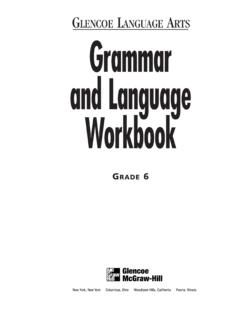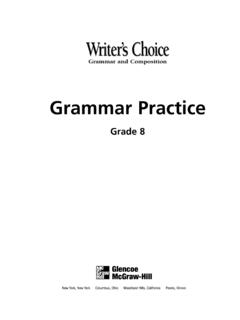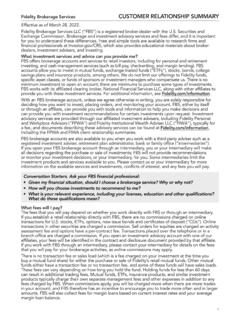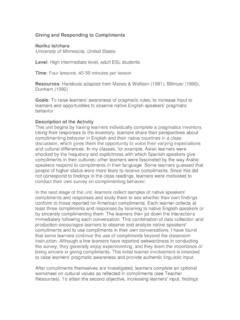Transcription of Creating Strong Report Card Comments - Weebly
1 < Strong >CreatingStrong > Strong < Strong >ReportStrong > Card < Strong >CommentsStrong > A Handbook for Jr / Sr High Teachers April 2011 2 < Strong >CreatingStrong > Strong < Strong >ReportStrong > Card < Strong >CommentsStrong > Try Try Not Maintain a focus on the child Relate < Strong >CommentsStrong > to the outcomes Focus on what was learned/achieved Use parent friendly language and maintain a focus on that audience remind yourself of what you would like to read about your own child. Give examples to help clarify the broad statements Identify strengths, challenges Connect next step(s) to the challenge(s) identified List what was taught Include < Strong >CommentsStrong > about attendance, homework, behaviour, attitude (this information can and should be included in the Learner Profile section of the < Strong >ReportStrong > card) Use teacher jargon Over-emphasize the negative (challenges) Mix speaking to parents and students interchangeably by inserting < Strong >CommentsStrong > such as Good Job, Jason! , or Bravo! etc. (These < Strong >CommentsStrong > should be reserved for the additional space at the end of the < Strong >ReportStrong > card.)
2 State what will be the focus for the whole class instruction during the next term. Throughout the < Strong >ReportStrong > card, for each comment that is written, maintain a student-centred focus. Keep these questions in mind: Will a parent reading these < Strong >CommentsStrong > understand clearly how his/her child is doing in your class/subject? understand that his/her child has areas of strength? know what is being done to address any areas of weakness? (This might also include ways the child can take some responsibility for his/her improvement and/or ways the family can support.) be aware of your interest in his/her child as an individual learner? The < Strong >ReportStrong > card < Strong >CommentsStrong > should reflect the child s achievement relative to the outcomes. Teachers should avoid a reiteration of the outcomes taught during the reporting period, but rather focus on the child s experience with them. 3 < Strong >CreatingStrong > Strong < Strong >ReportStrong > Card < Strong >CommentsStrong > Grades 7-12 Grades 7&8: Target and A 1. First, think about the learning targets for that term.
3 What should the student know and be able to do? 2. Next, write a generic comment for the student who is meeting expectations (A). , from Grade 8 ELA, Speaking and Listening contributes to a group discussion invites others into a discussion listens attentively and can identify main idea and key points actively listens (rephrases, clarifies, extends the discussion) is respectful of other ideas and contributions Student regularly contributes to small and large group discussions and seeks to involve others. (S)he listens attentively and is able to pick out the main ideas and key points from a discussion. (S)he does more than listen quietly. (S)he helps to extend conversations and asks for clarification when needed. Showing respect for others ideas and thoughts is also a strength. (378) NOTE: Once this generic or starter comment is made, it can be tailored to specific students. From A to B 3. Think about those students who are meeting most of the expectations (B).
4 From the list of targets, which ones are students most likely to struggle with (in italics below)? 4. Adjust the generic A comment to reflect challenges in these areas. This is your generic B comment (changes in bold below). contributes to a group discussion invites others into a discussion listens attentively and can identify main idea and key points actively listens (rephrases, clarifies, extends the discussion) is respectful of other ideas and contributions Student regularly contributes to small and large group discussions but needs to involve others more in the conversation. (S)he listens attentively and can pick out the main ideas and key points of a discussion. Showing respect for other ideas and thoughts is also a strength. (S)he is a quiet listener but does not consistently extend the conversation or ask questions of others for clarification. (398) NOTE: Once this generic or starter comment is made, it can be tailored to specific students. From B to C 5.
5 Think about those students who are meeting some of the outcomes (C). What is the next layer of targets most likely to pose a challenge for these students (in italics and underlined below)? Adjust the comment to reflect these challenges. This is now your generic C comment. 6. Adjust the generic B comment to reflect challenges in these areas. This is your generic C comment (changes in bold below). 4 contributes to a group discussion invites others into a discussion listens attentively and can identify main idea and key points actively listens (rephrases, clarifies, extends the discussion) is respectful of other ideas and contributions Student regularly contributes to small and large group discussions but needs to involve others more in the conversation. (S)he listens attentively quietly but is often not able to pick out the main ideas and key points from a discussion and (s)he rarely extends the conversation or asks questions of others for clarification.
6 Showing respect for others ideas and thoughts is also a strength. (394) NOTE: Once this generic or starter comment is made, it can be tailored to specific students. Grades 9-12 When assigning percentage grades for grades 9-12, rather than the letter grades applicable to grades 1-8, teachers could employ a similar process to the one outlined above. Thinking of students in ranges of achievement related to outcomes could result in generic or starter < Strong >CommentsStrong > being formulated and then edited as necessary for specific student needs. Given the six levels shown on the grades 9-12 < Strong >ReportStrong > cards ( , Excellent or outstanding , very good , good , satisfactory , minimally acceptable , and has not met minimum requirements ), teachers may want to create starter < Strong >CommentsStrong > for those six ranges rather than just four. Another Approach Identify the targets for the term. For each, write strength statements and challenge statements. Choose the strengths and challenges that best represent the student s level of achievement.
7 Regularly contributes to small and large group discussions seeks to involve others. listens attentively and is able to pick out the main ideas and key points from a discussion. does more than listen quietly; helps to extend conversations and asks for clarification when needed shows respect for others ideas and thoughts requires prompting and reminders to participate in small and large group discussions rarely involves others in discussion is a quiet listener but often struggles to understand the key points of what others are saying just becoming a more active listener and building on what others say only occasionally questions others for clarification at times needs to be reminded to be respectful of others opinions 5 < Strong >CreatingStrong > Strong < Strong >ReportStrong > Card < Strong >CommentsStrong > Sample Two Structure of a Comment Example *Opening / anchor sentence * State the level of overall achievement related to the subject area. Jane is meeting some of the expectations in math.
8 Using manipulatives she is able to add and subtract integers (positive and negative numbers) and is just beginning to understand how to multiply and divide integers. This is a concept Jane will continue to work on next term in class. Solving problems related to integers using symbols/numbers is something else that Jane struggles with. In algebra, Jane can identify the rules for the order of operations; however she has some difficulty applying this when solving linear equations. Next term, Jane will work in a small group to practice working on linear equations. (616) State the strengths What the evidence shows the student achieved/ learned. Identify challenges What the evidence shows the student has not yet achieved/ learned. Next steps Plans to address the student s challenges *optional: If space is a problem, it is not necessary to include an opening anchor sentence as it is described by the assigned grade 6 Useful Words and Phrases to Consider when Writing < Strong >ReportStrong > Card < Strong >CommentsStrong > Strengths Needs Suggestions - Able to construct, Able to determine, Able to extend, Able to research, Able to respond, Able to support - Can accurately.
9 , Can adapt, Can consistently .., Can easily .., Can effectively .., Can explain, Can identify, Can solve, Can successfully .. - Consistently makes - Continues to - Demonstrates a clear understanding - Demonstrates effective - Displays Strong , Displays exceptional - Has achieved - Has a good grasp of - Has successfully - Has learned - Has very good insight - Improved tremendously - Is able to - Is capable of - Is developing - Is consistently able to - Recognizes the importance - Shows commitment - Is competent in - Is proficient at - Is skillful at - Is very good at - Often uses - Recognizes that - Successfully interprets - Skillfully uses - Understands how, Understands that - Uses a variety of Some Action Verbs to Consider Using: - Attempts to, Makes attempts - Continues to need help with - Could profit by - Demonstrates a limited ability to - Does not always - Does not demonstrate - Encouragement with - Experiences difficulty with, Has difficulty with - Finds it difficult at times to , Has difficulty - Has not yet demonstrated the ability - Has not yet demonstrated understanding - Has trouble with - Is seldom able to - Is encouraged to - Is benefiting from practice with - Is learning to/that - Is receiving additional help with - Is working at - It is important that - Lacks a clear understanding - Needs more opportunities to - Needs ongoing help with, Needs ongoing assistance with - Needs support - Needs to clarify - Needs to develop - Often lacks - Rarely uses, Rarely able to - Requires adult support for - Requires more time - Seems to use few - Tries to, Makes attempts to - Struggles to.
10 Struggles with - Unable to explain - Can practice/apply at home by - Greater focus on - Is encouraged to - Is encouraged to be more - Is encouraged to seek - Is encouraged to strive to - Is not always willing to - It is recommended that - It is suggested that - Needs more time to develop - Needs to ask - Needs to be more open - Needs to consider - Needs to continue to - Needs to develop - Needs to expand on - Needs to improve, Needs improvement in - Needs to refer to - Needs to review - Needs reinforcement in - Needs to spend more time on, Should spend more time on - Needs time to - Needs to work on - Requires additional effort - Requires additional practice - Requires further understanding - Requires guided instruction - Should continue to - Should do further practice - Should take the time to - Should utilize options for - Should work towards - Would benefit from - Will have opportunities to - Applies - Builds - Compares - Completes - Constructs - Creates - Describes - Evaluates - Experiments - Explains - Expresses - Extends - Illustrates - Interprets - Knows - Organizes - Operates - Participates - Performs - Produces - Shows - Solves 7 Language Suggestions for Descriptors in < Strong >ReportStrong > Card < Strong >CommentsStrong > A* The student demonstrates achievement of the expected learning outcomes addressed during the current reporting period.






